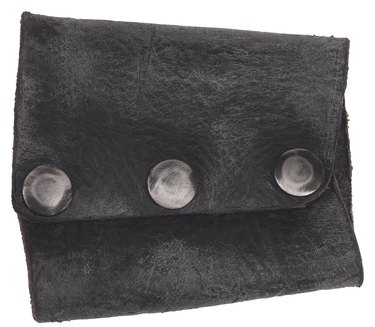
While commercial leather dyes provide durable color in a broad range of hues, you can save money and avoid hazardous chemicals by making natural leather dyes. Obtained from nontoxic plant materials such as roots, bark, leaves, wood, fruit and nuts, natural dyes have been used for centuries. Although some natural dye formulas are complex and call for ingredients that aren't readily available, there are simpler recipes for leather dye using easily found ingredients.
Acorns
Video of the Day
Acorns contain chemicals known as tannins that produce a permanent black dye when mixed with an acidic, iron-salt solution. For this process, you will need 15 large acorns, water, a cup of lemon juice and two tablespoons of rust powder, obtained by scraping rust from rusty nails, pipes or other metal objects. Crush the acorns into a powder. Mix the powder with just enough water to thoroughly immerse the leather material. Soak it overnight. In another container, combine the lemon juice and powdered rust to create an iron-salt solution. Wearing rubber gloves, remove the item from the acorn mixture and put it into the iron salt solution. Soak it again overnight. The acorn dye will chemically react with the iron salt solution, absorbing into the material.
Video of the Day
Berries and Grapes
Crushed berries and grapes create blue, red or purple dyes to stain leather. Black grapes and elderberries, in particular, have been used historically as natural leather dyes. Using these dyes involves applying berry or grape juice to the leather material, either by soaking or rubbing it into the surface. After hand-washing the leather material and wiping off excess water, soak the item overnight in berry juice or crushed berries mixed with water. You can also rub crushed berries into the leather or soak the item in red wine. If you have indigo pigment available, adding this color to berry or grape dye will intensify blue and purple hues. If desired, polish the dyed leather with olive oil after it dries.
Henna
Henna is a deep orange-red dye that comes from the leaves and shoots of the Lawsonia inermis plant. Native to the Middle East and India, the henna plant is widely cultivated for its intense pigment. After its leaves are dried and ground into a paste, henna can be used as a fast-acting color for dyeing hair, eyebrows, fingernails, textiles and leather. You can buy henna dye at most beauty supply stores. Follow the instructions on the product label to dye leather.
Vinegar and Steel Wool
Vinegar and steel wool produce a chemical reaction similar to the acorn and iron-salt mixture. Traditionally known in the United States as "vinegaroon," this black dye is made by soaking steel wool in water and allowing it to rust for as little as a few days or as long as a few weeks. Once sufficiently rusted, place the steel wool in a glass jar and pour boiling vinegar over it. Cover and let stand for several days. Dye leather items by dipping them into the solution for at least five minutes.